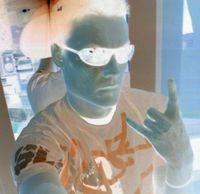
Shoemaker-Levy 9
Comet Shoemaker–Levy 9 (formally designated D/1993 F2, nicknamed String of Pearls for its appearance) was a comet that broke apart and collided with Jupiter in July 1994, providing the first direct observation of an extraterrestrial collision of solar system objects. This generated a large amount of coverage in the popular media, and the comet was closely observed by astronomers worldwide. The collision provided new information about Jupiter and highlighted its role in reducing space debris in the inner solar system.
The comet was discovered by astronomers Carolyn and Eugene M. Shoemaker, David Levy and Philippe Bendjoya from France. Shoemaker–Levy 9, at the time captured by and orbiting Jupiter, was located on the night of March 24, 1993, in a photograph taken with the 40 centimetres (1 ft 4 in) Schmidt telescope at the Palomar Observatory in California. It was the first comet observed to be orbiting a planet, and had probably been captured by the planet around 20 – 30 years earlier.
Calculations showed that its unusual fragmented form was due to a previous closer approach to Jupiter in July 1992. At that time, the orbit of Shoemaker–Levy 9 passed within Jupiter's Roche limit, and Jupiter's tidal forces had acted to pull the comet apart. The comet was later observed as a series of fragments ranging up to 2 km (1.2 mi) in diameter. These fragments collided with Jupiter's southern hemisphere between July 16 and July 22, 1994, at a speed of approximately 60 km/s (37 mi/s). The prominent scars from the impacts were more easily visible than the Great Red Spot and persisted for many months.
Kommentit
Haluaisitko kommentoida? Rekisteröidy käyttäjäksi tai kirjaudu sisään
Ei kommentteja.




